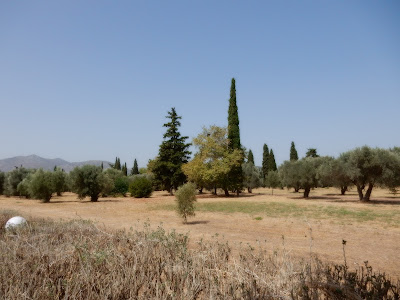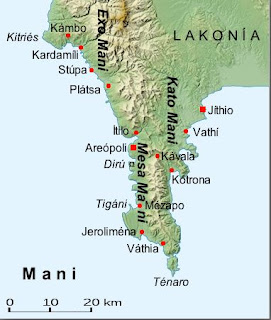One of the greatest joys of the journey to learning family
history is meeting fellow travelers. Never has this come so clear as when we
(my husband and I) visited Greece this September of 2015.
I first met Margarita Thomakou on genforum.com in 2008 (before the site was purchased by Ancestry) when she responded to my query about my Greek Flessouras family. In her response, Margarita said she lived in Athens and enjoyed helping Americans look for their Greek roots. We e-mailed occasionally over the years, just to keep in touch. About eight months ago, I let Margarita know that we were planning our first visit to Greece. She was as excited to welcome us to her country as we were to visit!
 |
Map of Greece
from CIA World Factbook,
22 August 2013,
gr.html,
Wikimedia.
|
I first met Margarita Thomakou on genforum.com in 2008 (before the site was purchased by Ancestry) when she responded to my query about my Greek Flessouras family. In her response, Margarita said she lived in Athens and enjoyed helping Americans look for their Greek roots. We e-mailed occasionally over the years, just to keep in touch. About eight months ago, I let Margarita know that we were planning our first visit to Greece. She was as excited to welcome us to her country as we were to visit!
Our tour was part family history, part Greek history and a
whole lot of Hellenic hospitality. Margarita met us at our hotel in Athens, and
we planned our itinerary. First we would go to Pigadakia, the ancestral village of the Flessouras clan,
which is in the Peloponnese between Tripoli and Sparta.
We had rented a car, and Margarita suggested that we follow
her. It was good to have two cars because sometimes Margarita would have some
business to conduct (she is in the real estate field) while we did some
sight-seeing.
“The cradle of civilization” is a phrase many of us heard in history class
applied to Greece. The Greeks are very proud of their history, including their
painting, sculpture, theater and poetry. But they have a special reverence, as
Margarita attested to, for the honor, courage, and fighting prowess displayed
over the eras by those who have inhabited the Greek land.
Our first visit was a day trip out of Athens to the town of Marathon. Many Americans, even those who
participate in running marathons, may not know where the word comes from. Well,
now I do. But first some history. Margarita took us to the site of the Battle of Marathon that occurred in 490 B.C. when the outnumbered Athenians
repelled the Persians.
Then she gestured to a huge hill behind us. This large mound is the final
resting place of the Greek soldiers who gave their lives in the battle.
And how did the modern marathon come from this historic battle? After the Greek victory, a messenger was dispatched to take the news to Athens – running all the way. The modern contest is a little over 26 miles, the same length as the distance from Marathon to Athens.
 |
| The battle field at Marathon as it looks today, 9/6/2015, taken by Bert Schuster |
 |
| Battle field relief, taken by Bert Schuster 9/6/02015 |
 |
| Burial Mound at Marathon, taken by Bert Schuster 9/6/2015 |
And how did the modern marathon come from this historic battle? After the Greek victory, a messenger was dispatched to take the news to Athens – running all the way. The modern contest is a little over 26 miles, the same length as the distance from Marathon to Athens.
The day after visiting Marathon, we started our trip to
Pigadakia. The chance to visit one’s ancestral village is a rare and precious gift. Just
before reaching the village, Margarita introduced us to a small restaurant all
by itself on the side of the road, a treasure as it turned out that you would
never find unless you had a wonderful guide. We sat eating and discussing
Pigadakia and the Flessouras clan. A neighboring diner had been listening to
our conversation and pointed out, in Greek of course, another departing diner:
“There, there is a Flessouras.” Well, luck, happenstance and chance are welcome
companions on any ancestor-hunting trip.
 |
| Street in Pigadakia, taken by Bert Schuster, 9/6/2015 |
 |
| Street in Pigadakia leading to small shrine, taken by Bert Schuster 9/6/2015 |
After Pigadakia, we headed to the Mani, Margarita’s ancestral homeland. She is proud to be from Maniot stock, and she knows the history of the land.
 |
By al-Qamar
(File:Peloponnese relief map-blank.svg)
[GFDL
(http://www.gnu.org/copyleft/fdl.html)],
via Wikimedia Commons
|
First, is Aeropolis (see map above), where, as Margarita told us proudly, the Greek War of Independence started in 1821. We stood in the very square where Petros Pierrakos (his birth name), later known as Petros or Petrobey Mavromichalis, declared war on the Ottoman Empire which had ruled Greece since 1453. In addition to the historical significance of Aeropolis, the village has much natural beauty and traditional houses.
 |
| Petrobey, a Greek Hero, in Aeropolis taken by Bert Schuster 9/9/2015 |
 |
| Typical Aeropolis street, taken by Bert Schuster 9/9/2015 |
 |
| Still life, Aeropolis, taken by Bert Schuster 9/9/2015 |
A second Mani destination with fascinating history was Vathia with its breathtaking sea views, century-old towers standing proudly next to new models, and acres of carefully dug terraces by farmers of old.
 |
| Sea view from Vathia, taken by Bert Schuster 9/9/2015 |
Margarita explained that the towers were built not only to protect the residents of Vathia from attacks from foreigners but also from the onslaughts of feuding neighbors.
 |
| Towers and terraces of Vathia, taken by Bert Schuster 9/9/2015 |
After a few days of sightseeing, it was time for some rest
and relaxation. Margarita took us to her favorite beach and hotel in this part
of the Mani, the Alkion Hotel/Apartments owned by Yannis Bechrakis.
What a paradise! After a day at the beach or visiting nearby scenic/historical attractions, you have only a short drive to Gythio with its choice of restaurants.
 |
| Beach in front of Alkion Hotel/Apartments, taken by Bert Schuster 9/10/2015 |
What a paradise! After a day at the beach or visiting nearby scenic/historical attractions, you have only a short drive to Gythio with its choice of restaurants.
Our week in the Peloponnese with Margarita came to an end
all too soon. We left her to finish her business in the Mani, and we took off
to Napflio and then to the islands of Naxos, Santorini, and Rhodes.
Two weeks
later on our last day in Athens, Margarita had a surprise for us. She took us
to her favorite hair salon which is located in the upscale Divani Caravel Hotel.
Bert and I spent the next two hours in the hands of the talented staff of Yannis’ Salon:
 |
August 21, 2015, Vasileos Alexandrou st., Athens, Greece, Flickr.com. |
Bert and I spent the next two hours in the hands of the talented staff of Yannis’ Salon:
Yannis -- the transformer of women, the man who makes
music and miracles with his scissors.
Anna -- the lady with the colors and the styles right from the red carpet
Kostas -- the master barber who gave Bert the shave of his life
Anna -- the lady with the colors and the styles right from the red carpet
Kostas -- the master barber who gave Bert the shave of his life

Great post! My mothers cousin married a man from the Pellopenese. He is one of the nicest people I have met. Keep up the great postings.
ReplyDeleteThank you, Dawna. I am so happy to have found the Hellenic Facebook groups.
DeleteExcellent post! I am related to the Petropoulos' from the area so it's nice to learn more about the area. Thanks for posting.
ReplyDelete